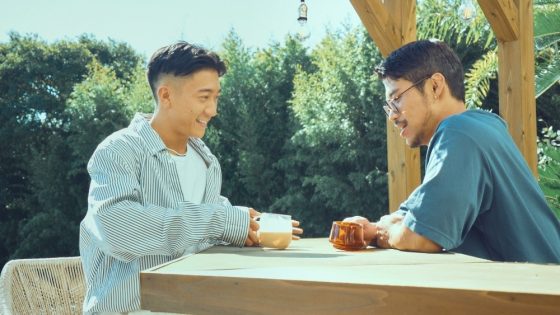Socially-conservative Japan seems to be in no rush to follow its neighbors in East Asia and roll out the pink carpet to the LGBTQ community or recognize same-sex marriages. But where the Japanese entertainment industry is slowly heading, courts and municipal authorities are following.
The untroubled July arrival of the country’s first same-sex dating reality show “The Boyfriend,” on streamer Netflix, may be another sign that normalization of queerness in Japan is on the way.
The show takes nine men to a beach house in order to find love — or at least friendship. For a month, they live together and take turns working shifts at a coffee truck, forging relations with other housemates and learning about themselves along the way.
“It’s no different from the familiar reality shows we’ve seen before. The only thing that felt odd or questionable was that, while there have been plenty of heterosexual reality shows, there have been so few featuring same-sex couples, and none in Japan,” casting director Taiki told Variety. “We didn’t aim to create a special genre.”
If the premise feels familiar, the result is a lightyear away from western shows such as “Love Island” or “Love Is Blind,” in terms of on-screen heat, excessive drama or unexpected events. “The Boyfriend” features very little kissing or fondling, let alone obvious sexual activity.
Through more than half of the show, there is an on-and-off relationship between Dai (a young and eager student) and Shun (who is fractionally older and more hot-and-cold). But the housemates’ biggest drama appeared to be a disagreement over the price of raw chicken.
Sex is rarely discussed directly. But sexuality and the difficulty of coming out as gay – one housemate, Taehon, has not yet told his parents, though being on a same-sex TV show means he inevitably must – are all frequently topics of conversation among the housemates. Mostly, they are thoughtfully and inoffensively handled.
Reviews of the 10-part show have been mostly positive and admiring of its restraint and warmth. The New York Times called it “wholesome and mostly chaste.” The U.K.’s Guardian praised it as “tantalizingly lovely.”
It was clearly designed this way. The housemates inhabit a soft pastel cloister decked out with Roche Bobois furniture. The men are casual and stylish, universally polite and carefully selected.
“We spent about six months gathering participants. We called for applications on my social media, received recommendations from friends and acquaintances, and even scouted in the gay district of Shinjuku Ni-chome,” Taiki says. “While it didn’t feel particularly challenging, we conducted many thorough interviews before finalizing the participants.”
Troublemakers were weeded out and producers sought to avoid any repeat of “Terrace House,” the (heterosexual) Fuji Television reality show which “The Boyfriend” closely resembles and was licensed by Netflix. After the fifth season of that show, female wrestler Kimura Hana died by suicide, having left multiple messages that alluded to bullying.
“The Boyfriend’s” producers did, however, seek to create ethnic diversity among the housemates, casting men of Korean and Taiwanese family origin, factors still considered as social stigmas in contemporary Japan.
Despite the lack of on-screen intimacy, producers say they were pleased with the profundity of the housemates and their progress. “I discussed with the cast how growth and valuable experiences stem from shared friendships, youth and struggles, not just romance. This led to many unexpected miracles on set,” said Hishida Keisuke, the show’s director and chief producer at Kyodo Television.
“Our focus wasn’t just on romance but also on spending time together and experiencing personal growth,” echoed Ota Dai, executive producer for live-action originals at Netflix Japan.
The show’s biggest fireworks may have been those coming from the studio, a lively five-person wriggle, resembling a watch party. The commentators included central host Megumi, an entertainer; drag queen Durian Lollobrigida; Tokui Yoshimi, a veteran of previous reality shows including “Terrace House”; Horan Chiaki; and style diva Thelma Aoyama.
“As this was Japan’s first romance reality show featuring male same-sex relationships, it was crucial to have someone from that community in the studio,” Lollobrigida told Variety. “Although my influence might be limited, by being a studio commentator who is a member of that community, I wanted to act as an interpreter … to help lower the barriers and deepen the understanding that viewers may have towards LGBTQ+.”
Other parts of the Japanese entertainment scene may be either embracing LGBTQ culture or becoming increasingly accepting.
A seminar at last year’s TIFFCOM, part of the Tokyo International Film Festival, discussing the massively popular “Boys Love” TV genre resembled something of a contest for bragging rights. While Thai producers boasted of their Asian leadership and the scores of “BL” shows they now produce annually, Japanese executives present were at pains to point out that “BL” originated as a subset of manga (Japanese comics) catering mainly to female fans and delivering stories of handsome young guys falling in love with each other.
Similarly, last year in his film “Kubi,” the venerable Kitano Takeshi re-wrote one of Japan’s most divisive historical events, a 16th century mutiny known as the Honno-ji incident, by portraying several of the male lead characters as lovers or ex-lovers. In response, the Japanese public largely shrugged.
So, while, “The Boyfriend” is unlikely to be labelled as revolutionary — and has yet to be given a second season — it nevertheless represents a small step towards a broadening and diversity of Japanese society.
“I don’t think this show has caused a 90-degree shift in public opinion, but it might have provided a moment for those who felt distant from LGBTQ+ people to realize that everyone struggles, enjoys life, makes friends and falls in love just like anyone else,” said Lollobrigida. “It could lead them to think, ‘Hey, they’re just like us.’”
“The Boyfriend”
Netflix
Source Agencies


